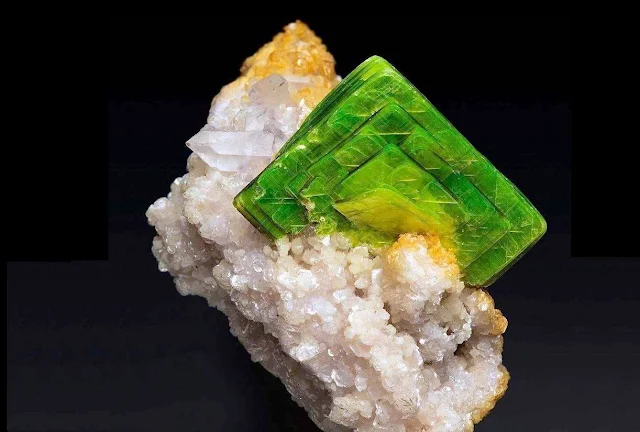Autunite: Properties, Occurrence, Uses
Autunite is a hydrated calcium uranyl phosphate mineral, valued as a uranium ore and for its yellow-green fluorescence.
What is Autunite?
Autunite is a bright yellow-green mineral containing uranium, valued for its fluorescence and role as a uranium ore. Its chemical formula, Ca(UO₂)₂(PO₄)₂·10–12H₂O, shows it is a hydrated calcium uranyl phosphate. As a secondary mineral, autunite forms when primary uranium minerals like uraninite break down near the Earth’s surface due to weathering. Found in uranium deposits, hydrothermal veins, and granite pegmatites, it is studied by geologists and collected for its striking appearance.
Why It Matters: Autunite’s presence indicates uranium-rich environments, helping geologists understand how uranium moves through the Earth’s crust. Its fluorescence makes it a favorite at mineral shows, and its uranium content ties it to nuclear energy production.
 |
| Autunite mineral cluster from Autun, France |
Properties of Autunite
Autunite has distinct physical and chemical traits that make it easy to identify:
Chemical Formula: Ca(UO₂)₂(PO₄)₂·10–12H₂O
Crystal System: Orthorhombic, forming thin, nearly square crystals (angles 89°17′)
Color: Lemon-yellow to sulfur-yellow, sometimes greenish-yellow or dark green, with slight color shifts (pleochroism) in thin slices
Crystal Habit: Flaky (micaceous), scaly aggregates, crusts, or fan-like clusters with perfect basal cleavage
Luster: Glassy (vitreous) to pearly on cleavage surfaces
Hardness: 2–2.5 on the Mohs scale, soft and easily scratched
Specific Gravity: 3.05–3.19, heavy due to uranium
Fluorescence: Glows bright green to lime-green under ultraviolet (UV) light, a key feature for identification
Radioactivity: Contains about 48% uranium, making it radioactive. Small specimens are safe for brief handling, but long-term exposure may raise health risks, such as cancer.
Dehydration: In dry air, autunite loses water, turning into meta-autunite (Ca(UO₂)₂(PO₄)₂·2–6H₂O), which is dull, brittle, and less fluorescent. Collectors store it in sealed, humid containers to preserve its look.
These properties help geologists spot autunite in the field, especially with a UV light. Its softness and flakiness mean it breaks easily, while its transformation to meta-autunite shows how minerals change with environmental conditions, a key idea in mineral stability.
 |
| Autunite Radioactive Mineral. Unique Autunite (Meta-Autunite) from Golconda pegmatite district, Brazil. Photo by: Thomas Spann |
Where is Autunite Found?
Autunite forms when primary uranium minerals, like uraninite, are exposed to oxygen and water near the Earth’s surface. The uranium dissolves in groundwater, then combines with calcium and phosphate (often from minerals like apatite) to form autunite. It occurs in three main settings:
- Oxidation Zones: Most common in uranium deposits, where weathering creates autunite as a secondary mineral.
- Hydrothermal Veins: Formed when hot, mineral-rich fluids deposit uranium in rock fractures.
- Granite Pegmatites: Rare, in coarse-grained igneous rocks with uranium pockets.
Key Locations:
- Autun, France (discovered in 1852, named after this site)
- Viseu district, Portugal (fine crystals on smoky quartz)
- Daybreak Mine, Washington, USA (fan-like crystal groups)
- Mount Painter Mine, South Australia
- Vogtland, Germany
- Malacacheta pegmatite, Minas Gerais, Brazil
- Utah, Wyoming, New Hampshire, USA
Associated Minerals: Torbernite, uranocircite, uranophane, uraninite, pitchblende, and sometimes silver, tin, or iron ores.
Autunite’s presence in oxidation zones helps geologists locate uranium deposits for mining. Its global distribution, from France to Brazil, shows how uranium cycles through different geological settings, aiding research on Earth’s crust processes like weathering and fluid movement.
Uses of Autunite
Autunite’s uranium content drives its primary uses, with some historical and potential applications:
Uranium Ore: With 48.27% uranium, autunite is a key source for nuclear power, where uranium fuels fission reactions. Mining requires strict safety measures due to radioactivity.
Historical Uses: In the early 20th century, autunite was used in photoelectric tubes for electronics, like early TVs, and as a yellow-red pigment in ceramics. These uses stopped due to health risks.
Hypothetical Uses: Research suggests autunite could trap pollutants for environmental cleanup or yield trace elements like vanadium or rare-earth metals. These ideas need further testing to confirm their feasibility.
Autunite’s role in nuclear energy makes it economically important, but its radioactivity limits other uses. Future applications could expand its value in environmental science, pending studies to verify effectiveness.
Safety Guidelines
Autunite’s radioactivity requires careful handling to avoid health risks:
- Store in labeled, ventilated containers away from living areas.
- Limit handling time and wash hands after contact.
- Avoid keeping near personal items or in enclosed spaces.
- Professionals should handle it during mining or lab work.
Small autunite specimens pose low risk with brief handling, but prolonged exposure can accumulate radiation, aligning with safety standards from groups like the International Atomic Energy Agency. Proper storage protects collectors and researchers.
 |
| Autunite cluster from Minas Gerais, Brazil |
Summary
Autunite is a vibrant, uranium-rich mineral that glows under UV light and serves as a key uranium ore. Formed through weathering in uranium deposits, it is found worldwide in places like France, Portugal, and the USA. Its properties aid geological research, and its uranium fuels nuclear energy. While safe with precautions, its radioactivity demands care. Ongoing research may reveal new uses, making autunite a fascinating mineral for study and industry.



%20(1).webp)





